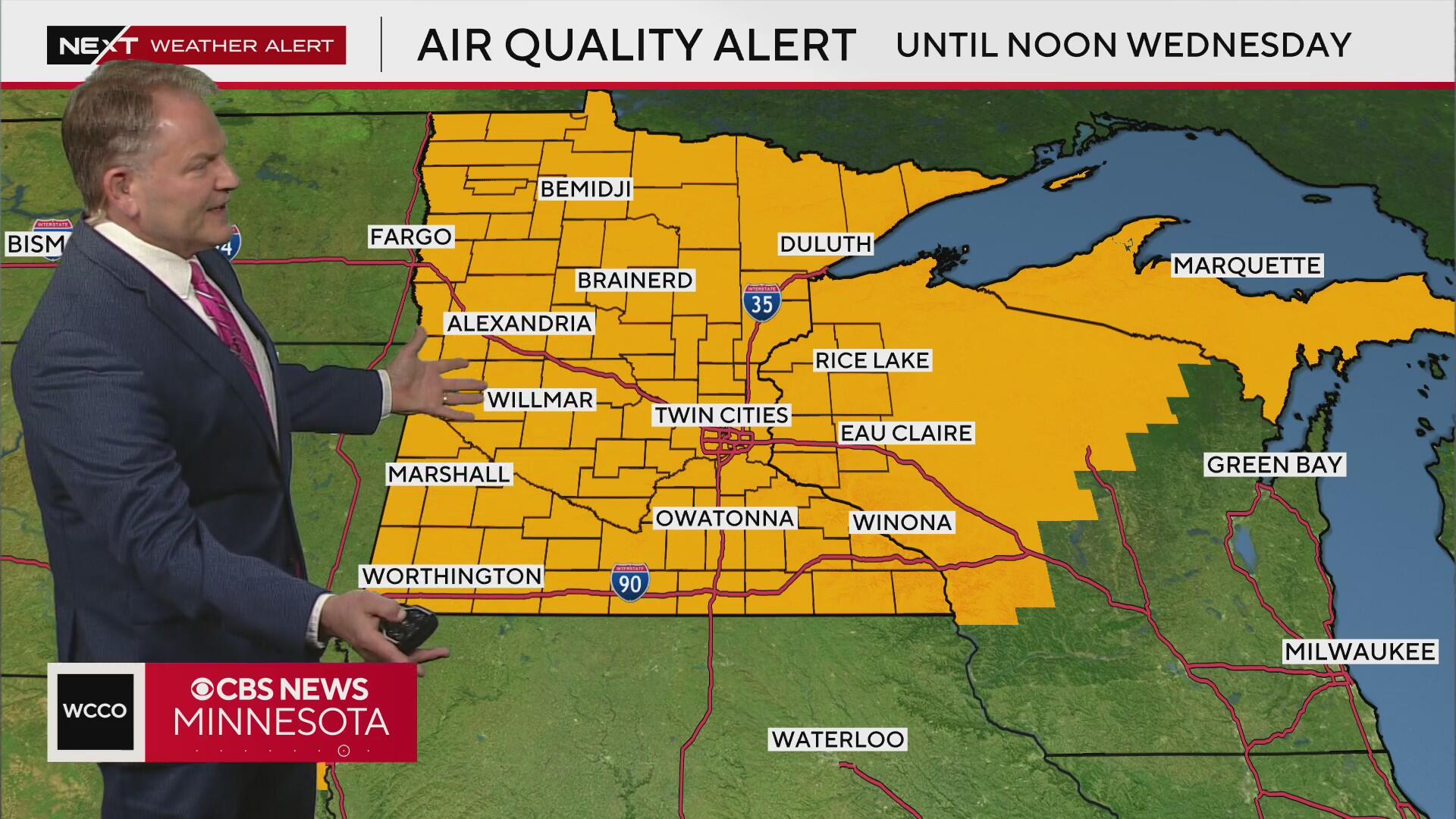Air quality alert extended in Minnesota as heat builds, storms arrive
Monday will be hot and hazy in the Twin Cities, with highs in the low 90s.
The extended its air quality alert on Monday for another couple days due to lingering Canadian wildfire smoke. It is now set to expire Wednesday at noon, but another extension is possible. There is a NEXT Weather Alert in effect through Tuesday morning due to the poor air.
Showers and storms were set to move through the region on Monday night along with a cold front, but behind that front, wildfire smoke could be brought down to the surface.
The metro is expected to reach the unhealthy category, meaning the air is considered unhealthy for everyone and not just sensitive groups.
The forecast is also calling for hazardous air quality for northwestern Minnesota. This is the first time the MPCA has used an alert category of hazardous since they started issuing these type of alerts in 2011.
The forecast is calling for very unhealthy air from Brainerd to the northwest, a category that has only been used once before. The smoke is expected to arrive after the storms tonight, and linger into tomorrow morning.
Tuesday will start with rain and rumbles, with cooler highs near 70 degrees.
Wednesday will be dry and milder with sunshine returning.
There is a slight chance of showers on Thursday with highs in the upper 70s.
Friday will bring a chance for scattered storms, but will otherwise be a warm and breezy day.
Severe storms possible Monday evening
A severe thunderstorm watch is in effect until 7 p.m. for areas northwest of the metro including Fergus Falls, Alexandria, Brainerd and St. Cloud.
The main threat for the area is ping pong-size hail, strong wind gusts and lightning.
A severe thunderstorm warning is also in effect for the Sauk Centre area until 3:30 p.m.
In the Twin Cities, there is a 1/5 chance for severe weather. It'll likely hit the metro after 6 p.m., and the severity of the storms will diminish in the east.
More on air quality alerts
The pollution control agency says the air quality alert extension is due to a "band of very heavy ground-level smoke" entering Minnesota from the northwest and moving southeast across the state.
"This sets the stage for the continuation of a long-duration significant wildfire smoke event for Minnesota," the agency said.
On Monday, the northwest corner of the state will deal with an of maroon — the most hazardous category. Northwestern and north-central Minnesota will be in the purple category, a step below from maroon, signifying "very unhealthy" air. It's the first time the Minnesota Pollution Control Agency has issued the maroon alert since they started issuing alerts in 2011.
The smoke will enter northeastern and central Minnesota, including the Twin Cities, by Monday afternoon, where AQI level will be red, or simply "unhealthy."
Southeastern and southwestern Minnesota will get this round of smoke by Tuesday morning and will be in the orange category, meaning the air is "unhealthy for sensitive groups." Air quality is expected to improve significantly by Wednesday, the agency said.
More than 25,000 people have been forced to flee their homes as Canadian wildfires burn through thousands of acres. Most of those evacuees are from Manitoba, where a state of emergency was declared last week.
The Canadian Interagency Forest Fire Centre reports 184 active wildfires in Central and Western Canada, with 94 burning out of control.
How to prevent exposure to hazardous air
The smoke from the wildfires is essentially poisoning the air in Minnesota and neighboring North Dakota, Wisconsin and Michigan.
found matter from wildfire smoke can have health effects up to three months.
"It's this higher concentration that you're breathing kind of overwhelms your body and can lead to health issues that we kind of expect from air pollution," said Peter DeCarlo, environmental health and engineering professor at Johns Hopkins University.
Minnesotans may need to prepare for another summer of smoke, like what the state experienced in 2023. Experts say it's possible the state could also have to deal with wildfire smoke from out west
The National Weather Service says rain on Monday will likely help bring smoke down closer to the ground. Exposure to this air brings symptoms including itchy eyes, sore throats and headaches. People are advised to avoid spending prolonged amounts of time outdoors, and consider wearing a well-fitting N-95 mask.
"It can be hazardous to your health, especially people who are especially sensitive to things like that," said National Weather Service meteorologist Melissa Dye. "People with asthma, elderly, children."
Motorists are also advised to consider reducing trips. If you have to drive, recirculate the air in your vehicle to reduce exposure to harmful particulate matter.








